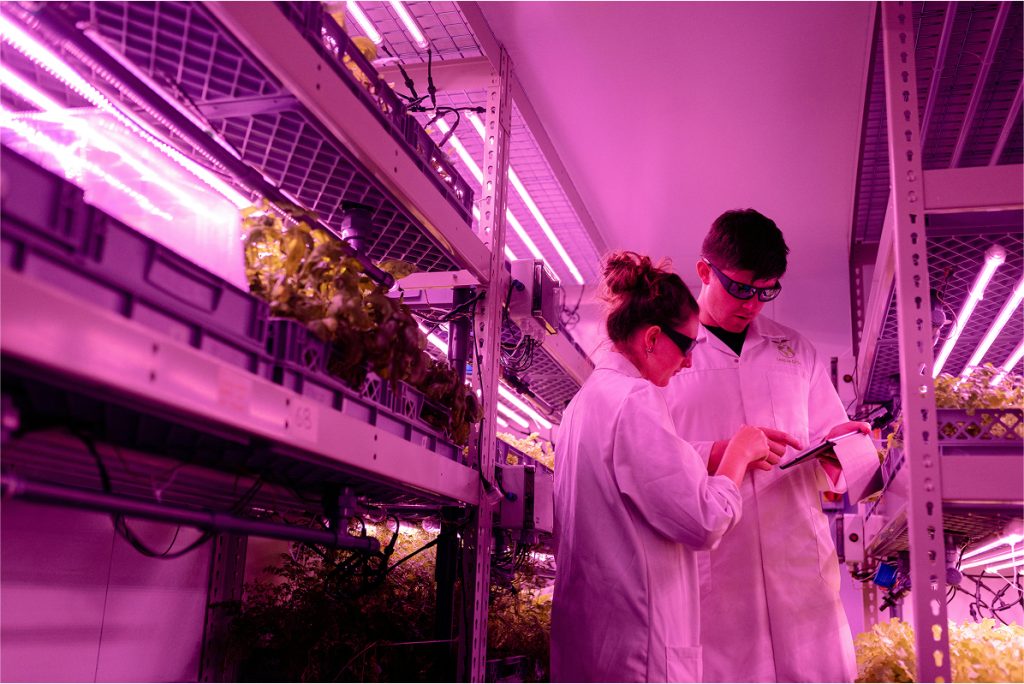
Chapter 05
Build the Biotechnology Workforce of the Future
Chapter 05
introduction
America’s greatest strength has always been its people. Bold, creative, and driven individuals have propelled the United States’ unyielding pursuit of progress. That same spirit of progress must be harnessed to build a workforce that can lead the world in biotechnology innovation. To fully realize biotechnology’s potential to defend, build, nourish, and heal, the United States must strengthen and sustain a talent pipeline.
The need for talented biotechnology workers has never been more urgent. Tomorrow’s biotechnology workforce will be comprised of people of all backgrounds, experiences, and skillsets. The United States will still need scientists, researchers, and will also need technicians, educators, policymakers, business leaders, and innovators at every level.270 It is these problem-solvers and creative thinkers who will lead the charge into a healthier, more secure, and more prosperous future.
To build this workforce, the U.S. government, academic community, and private sector must work together to advance bioliteracy. Bioliteracy is the ability to understand and engage with biology and biotechnology.271 Ideally, Americans will soon understand biology and biotechnology in the same way that they understand how computers and information technology interact with their daily lives. Widespread bioliteracy will mean a more informed, empowered, and resilient society capable of leveraging science and technology to solve a wide range of global challenges.
There are three critical workforce gaps that this chapter addresses: the U.S. federal workforce, the country’s domestic workforce, and foreign talent.
Congressional offices and federal agencies consistently highlight the growing demand for skilled biotechnology professionals. There are very few biotechnology experts in the federal government, and many of those existing workers are busy running current biotechnology programs. There are very few senior officials at the Assistant Secretary level or higher that are trained in biotechnology or life sciences. A small fraction of Members of Congress are trained scientists. Across the rest of the federal government, many workers have not had biology training since high school. Government officials cannot design or execute policies and programs affecting biotechnology without a general understanding of the underlying concepts.
The United States is also not prepared to meet the broader domestic workforce needs of the country’s growing and evolving biotechnology industry. There has been a major, sustained demand for workers familiar with new vaccine platforms, advanced computational and AI-driven biotechnology, cell and gene therapies, and precision medicine since 2017. But the United States’ supply of workers is failing to meet this demand.
In this global race for biotechnology talent, the United States is losing ground to China.272 The sheer size of China’s population gives the country a natural advantage over the United States in human capital. China produces far more STEM PhDs and master’s degree holders than the United States does, and it and other countries are quickly becoming compelling alternative destinations for the world’s best biotechnology minds.273 Top U.S. scientists have been offered custom buildings, facilities, and entire departments at institutions in China. Even early-stage researchers have been targeted, with post-docs receiving extremely competitive offers to start labs in China.
If the United States is to stay globally competitive, it must remain the top destination for the best and brightest in biotechnology. Maintaining that position will require new mechanisms to attract and retain trusted, highly skilled talent from around the world, as well as improved vetting and screening mechanisms to protect against foreign espionage and forced technology transfer. The government must also ensure that those vetting and screening mechanisms do not discourage international students and innovators from bringing their talents and innovations to the United States.
The federal government has a clear and distinct role in addressing workforce development in the federal government, in the country at large, and internationally. The U.S. government is in charge of its own federal workforce; Congress has the power to set policies for recruiting, retaining, and screening foreign talent; and there is precedent for the federal government to prioritize national-level education initiatives of strategic national security importance.274 Most domestic workforce and education initiatives, however, are handled at the state and local levels. While the Commission is focused on actions that the federal government is uniquely positioned to take, state and local policies can bolster its efforts with the support of the private sector. Industry can also support community bioliteracy alongside workforce development.

“In order to support the biotechnology industry of the coming decades, we need to invest in our workforce. We are fortunate to live in a time when biotechnology will have such an enormous impact on our everyday lives. I have had the privilege of working with, encouraging, and mentoring the next generation of STEM innovators, from kindergartners through postdoctoral fellows, in my 30 years as a STEM educator. In those years, I have worked with eager learners who are immensely curious and have a drive for innovation to solve the most challenging problems facing our nation and our planet. To prepare a biotechnology workforce of the future, we need to invest in our domestic talent pipelines. And as we continue to build and support our homegrown talent, it is important that we create a welcoming and supportive environment where the best global talent will seek to come and contribute to our innovation ecosystem.
We now have the opportunity as well as the urgency to implement policies that support the development of a workforce capable of defending, building, nourishing, and healing the nation. Policies supporting talent development will expose people at all stages of learning, from our youngest learners to our country’s leaders, to cutting-edge STEM technologies and their potential. They will also provide access to new educational pathways to future biotechnology careers, especially in translating and scaling technologies, which will require a basic STEM understanding and an interdisciplinary skill set. And they will provide opportunities for the American people to feel comfortable with the complex concepts of biotechnology, as it relates to their health, their food, and their environment.”
Commissioner Angela Belcher